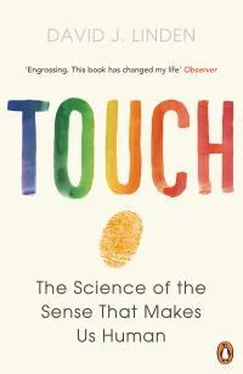
The powerful effects of culture, gender, and social situation on interpersonal touch perception raise a crucial question: How can the very same sensation (say, a brief arm-around-the-shoulder squeeze) delivered with the identical pressure and dynamics and leading to precisely the same signals conveyed to the brain from the skin and muscles give rise to such different perceptions in the people experiencing it? Importantly, it’s not that such sensations feel the same to all individuals at the moment they experience them, but are then interpreted differently upon reflection. Rather, they actually feel different from the very first instant they can be consciously detected. The tactile perception of an around-the-shoulder squeeze from a domineering boss feels fundamentally different from the same gesture received from a good friend, which in turn feels different from that of a lover. The raw stuff of tactile sensation must be combined with the imprints of our life experience—starting in the womb and continuing to the present moment, soaking up culture and gender roles and personal history along the way—to ultimately produce our highly nuanced perception of social touch. This combination of the past with the present has to take place within about a tenth of a second. Now our task will be to explore how the biology of skin, nerves, and brain underlies this crucial integrative aspect of our lives as social animals.

CHAPTER TWO
Pick It Up and Put It in Your Pocket
Even the giants of philosophy can have a bad week. Aristotle, for example, struggled mightily with the problem of human cognitive superiority. How can humans be so much cleverer than other creatures when the hawk has keener eyesight, the dog has a finer sense of smell, and cats have more acute hearing? 1Pondering this dilemma, Aristotle came to believe that human touch sense was unusually acute, and that it was this acuity that accounted for the superior intellect of our species:
The human being is left behind by many of the animals, but with respect to touch he is precise in a way that greatly surpasses the rest, and this is why he is the most intelligent of the animals. A sign of this is that within the human race, being naturally well or badly endowed with intelligence depends on the organ of this sense and not on the others, for those with tough skin are badly equipped by nature for thinking, but those with tender skin are well equipped. 2
Research on the biology of touch has not supported either the basis or the inference of Aristotle’s argument. In fact, our tactile perception is not the most sensitive of all animals. Furthermore, among humans there appears to be no correlation between intelligence and either skin softness or acuity of fine touch perception. How did the philosopher get this so wrong? It’s likely that Aristotle had an agenda based upon social class: In his view, slaves and others whose hands were roughened by manual labor were clearly not as bright as philosophers and nobles, the soft-skinned elite.
What Aristotle didn’t know is that we (and other animals) have an array of many types of touch sensors in the skin, each a beautiful, specialized micromachine sculpted by evolution to extract different aspects of information about our tactile world. The nerve fibers that relay the information from these touch sensors to the spinal cord are mostly dedicated to a single class of sensation, one for texture, another for vibration, another for stretching, and so on. When we use tactile information to play the violin or make love or take a sip of coffee, we don’t have to think about the array of various sensors in the skin. The streams of information from these sensors are blended and processed in our brains, so that by the time we have conscious access to them, they are in the form of a unified and useful percept. Moreover, touch information is subconsciously combined with inputs from vision, hearing, and proprioception (a sense of where our bodies are located in space that comes from nerve endings in our muscles and joints) to give rise to rich, nuanced perception.

The skin is an interface between our internal and external worlds and is, by virtue of this topology, the locus of touch. In addition to allowing touch information in, it has to keep a lot of dangerous things out. Skin serves as a barrier to repel noxious stressors like parasites, microbes, mechanical and chemical insults, ultraviolet radiation, etc. To aid in this task, it has its own specialized branch of the immune system and secretes its own hormones. 3The skin of an individual human is surprisingly big. If, in the tradition of the splatter film, I were to fall victim to a leering psychopathic murderer and she were to carefully flay my corpse, my resultant hide would weigh about as much as a bowling ball (14 pounds), making it the largest organ in the human body. To get a stomach-lurching sense of the skin’s total surface area, imagine taking delivery of nine family-sized pizza boxes and laying them in a three-by-three grid on the floor. 4
There are two basic types of skin: hairy and hairless. The medical term for skin without hair is glabrous, 5and you might think that glabrous skin can be found in lots of smooth places: Keira Knightley’s cheek, for example. But if you were to look carefully, you’d find that this lovely soft patch of her face is actually covered with many fine, short, light-colored hairs called vellus hairs. Other apparently smooth places on the human body, like the inner bicep or inner thigh, also have them. These soft vellus hairs have an essential wicking function, drawing perspiration away from the skin and thereby increasing the efficiency of evaporative cooling. The only true glabrous skin is found on the palms of the hands (including the inner sides of the fingers), the soles of the feet, the lips, the nipples, and portions of the genitals. 6In women, the skin of the labia minora and the clitoris is glabrous, but the skin of the labia majora is hairy. For men, the foreskin and the skin covering the head of the penis, called the glans, is glabrous, but the shaft of the penis is hairy (even on glistening, chemically depilated porn actors).
Hairy and glabrous skin have the same general structure. Imagine a two-layer cake with the top layer divided into sublayers (figure 2.1). Both types of skin have an outermost sublayer of flattened dead skin cells, called the stratum corneum, and three underlying sublayers, each of which contains a mixture of several types of living cells, including keratinocytes, Langerhans cells (which are part of the immune system), and melanocytes. The melanocytes manufacture granules of the pigment melanin, which is the main determinant of skin color. Together, these four sublayers comprise the epidermis. The cells of the epidermis are continually regenerated, with new ones created by cell division in the deepest sublayer, gradually migrating upward. In this migration, the cells flatten as they are pushed up from below, and their internal structure breaks down, leaving, in the stratum corneum, tough, pancake-shaped cell husks that are ultimately shed from the skin surface. In this way, the epidermis is completely renewed about every fifty days. Below the epidermis is another layer, the dermis, which contains nerves, blood vessels, sweat glands, and a dense network of elastic fibers.
The key structural differences between glabrous and hairy skin are shown in figure 2.1. Hairy skin has both fine, pale vellus hairs and also the longer and thicker, more visible guard hairs. The epidermis of glabrous skin tends to be thicker than that of hairy skin. 7It also has a different shape—wavy, rather than flat. On the surface of the skin, we know these wavy ridges, called papillary ridges, as fingerprints (and toe, palm, and sole prints, as well). The internal face of the wavy epidermis forms partially complementary structures called primary and secondary epidermal ridges, and we can think of them as inward-facing fingerprints.
Читать дальше














